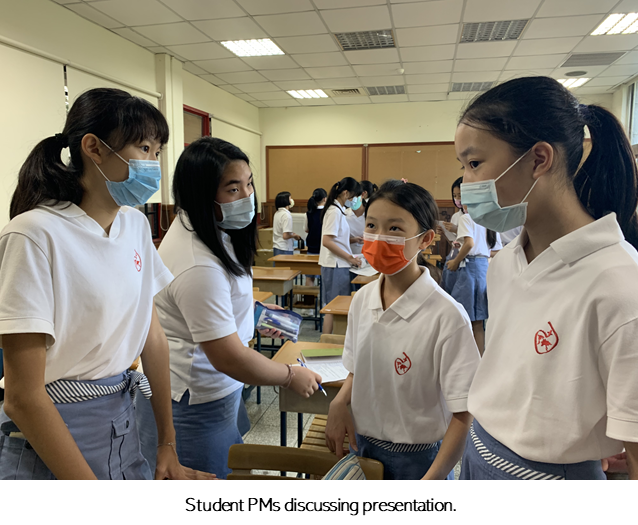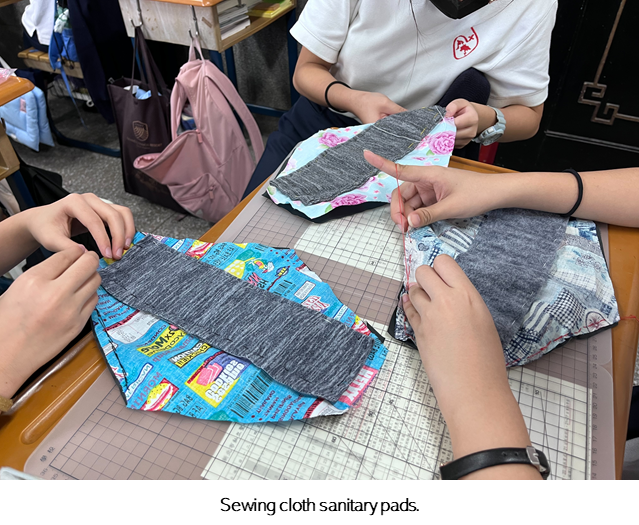The Charity Bazaar has always been a big event at the Sacred Heart High School for Girls in Taiwan, but the Covid-19 pandemic has changed many aspects of educational life. When the CDC (Centers for Disease Control) in Taiwan announced a mask mandate, the activities that could not comply with social distancing and the mask mandate, such as the Charity Bazaar, had to be cancelled. The “Caring for Women” project was created out of these challenges, as a new learning project and experiment that kept the spirit of the Charity Bazaar alive.

Just like the Charity Bazaar, which involved all school members, the Caring for Women project is also part of a comprehensive and interdisciplinary educational plan. A specific task was assigned to each grade. Grade 7 looked for Taiwanese female role models who made philanthropic contributions to society. Grade 8 and 9 studied the issue of child marriage in different countries. Grade 10 learned about the issue of period stigma. Grade 11 and 12 focused on the issue of period poverty. Each class appointed one or two students as project managers (PMs) who would be trained and supervised by the Dean of the Student Affairs Office and homeroom teachers.
The whole project began with student PMs studying the learning materials provided by social studies teachers. After digesting those materials, student PMs would explain to their classmates how the homeroom class as a whole could participate in this project, including what the issue was about, what kinds of questions they were curious about, what goals they wanted to achieve in terms of their learning outcomes, and finally, how they wanted to interact with Sacred Heart schools in other countries on these issues.
Aside from the interaction with overseas students, outcome presentations within the school and between different grades were also arranged. Seventh and eighth graders listened to each other; ninth and tenth graders listened to each other; twelfth graders listened to eleventh graders. Senior and junior students listened to each other and gave feedback to promote the positive learning atmosphere for the whole school.
This project had two ultimate goals. The first one was to rebuild the connection with sister Sacred Heart schools around the globe. By sharing what Taiwanese students learned and asking for feedback via the internet, the interactions among Sacred Heart schools were strengthened. The cultural exchange director, Maggie, used emails to match each class to an overseas Sacred Heart school. Three elements were required for Taiwanese students when preparing the materials to be exchanged: they needed to introduce the issues involved; they had to share their own opinions or reflections; and they needed to request feedback from the overseas students.

The second goal of this project was to take action for girls in need. The Little Red Hood Association aims to serve girls of low socioeconomic status in Taiwan by providing sanitary supplies and education. In order to support their work, a fundraising for Little Red Hood was launched during the project. Besides donating money, some students sewed cloth sanitary pads for disadvantaged women in Africa. These cloth sanitary pads were delivered to the girls in need in Africa through Love Binti International Association, which is a Taiwanese organization aimed at improving health and sanitary conditions for African women. In carrying out these actions, the students embodied the five goals of Sacred Heart Education, which are:
1) A personal and active faith in God;
2) A deep respect for intellectual values;
3) A social awareness that impels to action;
4) The building of community as a Christian value;
5) Personal growth in an atmosphere of sensible freedom.
A final collective artwork created by all of the classes was displayed in the school. This artwork was made of fabrics, echoing the idea of cloth sanitary pads. According to what students learned, each class came up with a woman’s portrait. All of the female faces shown on the wall conveyed a message to our school members; all of the women are unique, in terms of skin color, race, culture, age, etc., and all of them are precious and deserve a life with dignity.
The Caring for Women project was progressively developed as it was implemented. It began with the school principal organizing a group of teachers and administrators to discuss the project’s goals and issues. Then student PMs got involved, bringing their creativity and resources, as well as those of their classmates, into the project. Many students and teachers gave positive feedback afterwards. For example, teachers observed the positive interaction between high school and middle school students. In order to set up a good cross-class presentation, student PMs did a lot of communication and cooperation beforehand. Once they had formulated their plans, student PMs returned to their classes and led their classmates to finish the work. On the day of the outcome presentation, students of different ages listened to each other, learned from each other and grew together.
Almost all the students, who have rarely seen child marriage and period poverty in their lives, said that they learned a lot about the issues involved. For some girls, it was an eye-opening experience to realize how many girls are suffering because of these two issues, and this in itself was valuable for them.
Lucia Wang
For more information (in Chinese): Sacred Heart "Caring for Women" Project.
